Quantum Computing and Quantum Sensing (QuMeCo)
Ambitions and scientific objectives
Quantum technologies for computing, simulation, sensing, and communication crucially rely on the ability to control and measure individual quantum objects while preserving their quantum-coherent properties. Common to all quantum technology platforms and application areas is thus the overarching goal to enhance our capabilities in the measurement and control of quantum systems while sustaining their protection against environmental noise. The project QuMeCo strives to address this central challenge in the enablement of quantum technologies with research at the intersection between the natural and engineering sciences. It aims to explore high-risk, high-gain alternatives to existing measurement and control solutions. Specifically, QuMeCo develops ultrafast photon detectors and single-photon sources, explores novel schemes for the readout of biological structures, develops measurement schemes for superconducting qubits, and uses molecules and color centers as detectors of fields and photons.
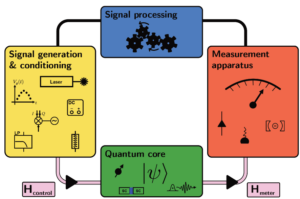 The QuMeCo consortium connects 12 partners from both the physics and electrical engineering department of FAU and from the Max-Planck-Institute for the Science of Light (MPL). They cover a broad range of complementary research areas offering excellent collaborative perspectives on a variety of interdisciplinary challenges. In addition to novel measurement and control schemes for quantum computing, QuMeCo strives to develop new concepts and hardware for quantum measurement and control in the area of quantum sensing. The aim is to measure quantities such as magnetic or electrical fields or to enhance the resolution in imaging and spectroscopy by exploiting quantum effects such as superposition, entanglement, and sub-shot-noise correlations. QuMeCo will add long-standing expertise at FAU in the domain of quantum sensing, with prospects for important Bavarian contributions to the second quantum revolution.
The QuMeCo consortium connects 12 partners from both the physics and electrical engineering department of FAU and from the Max-Planck-Institute for the Science of Light (MPL). They cover a broad range of complementary research areas offering excellent collaborative perspectives on a variety of interdisciplinary challenges. In addition to novel measurement and control schemes for quantum computing, QuMeCo strives to develop new concepts and hardware for quantum measurement and control in the area of quantum sensing. The aim is to measure quantities such as magnetic or electrical fields or to enhance the resolution in imaging and spectroscopy by exploiting quantum effects such as superposition, entanglement, and sub-shot-noise correlations. QuMeCo will add long-standing expertise at FAU in the domain of quantum sensing, with prospects for important Bavarian contributions to the second quantum revolution.
Work package 1: Measurement of superconducting qubits for next-generation error-corrected quantum computing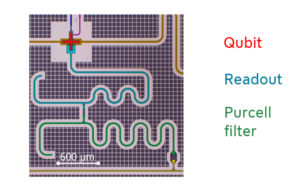
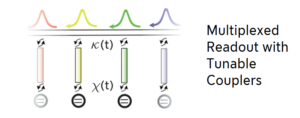
The measurement process is at the heart of quantum physics. The amount of information one can gain about a system is limited by the backaction of a measurement device on the system under test. Therefore, it is particularly important to avoid any measurement imprecision originating from classical noise, and to efficiently and controllably couple the measurement apparatus to the probed quantum system without altering its unitary dynamics. Because of this, work package 1 focuses on the improvement and development of suitable measurement processes. These novel capabilities will thus enable us to tackle new territory in both, experiment and theory, at the interface of condensed matter and quantum technology research.
Work package 2: Concepts and implementation of scalable and real-time quantum control via multiplexing and machine learning
Th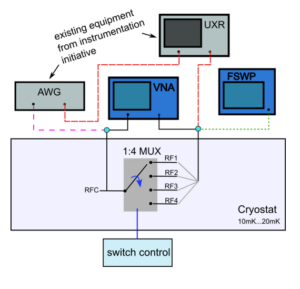 e control and manipulation of quantum information processing systems is commonly achieved by applying tailored electromagnetic control signals to the system. Successfully accomplishing this task relies on multiple components. As part of QuMeCo we will develop new concepts and build physical hardware to enable frequency- and time-multiplexed control and measurements, which has great potential to reduce the resource requirements in scalable QIP architectures. Moreover, we will explore the use of machine learning in real-time quantum control, which is particularly important in the context of quantum error correction.
e control and manipulation of quantum information processing systems is commonly achieved by applying tailored electromagnetic control signals to the system. Successfully accomplishing this task relies on multiple components. As part of QuMeCo we will develop new concepts and build physical hardware to enable frequency- and time-multiplexed control and measurements, which has great potential to reduce the resource requirements in scalable QIP architectures. Moreover, we will explore the use of machine learning in real-time quantum control, which is particularly important in the context of quantum error correction.
Work package 3: Quantum sensing and imaging: from sources to detectors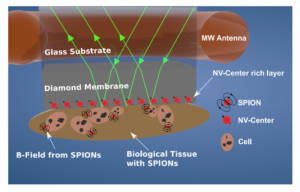
In Quantum measurements, an unprecedented level of sensitivity and resolution is required. This applies to magnetic or electrical field sensing, imaging, and spectroscopy. Enhancing the capabilities of quantum sensing and imaging to a new level crucially relies on enabling technologies such as quantum light sources, coherent manipulation schemes, and novel quantum detectors. In work package 3 we will develop entangled photon sources in ‘difficult-to-access’ spectral domains like the mid-infrared or the UV and exploit the correlations between entangled photons for ultrasensitive measurements.

